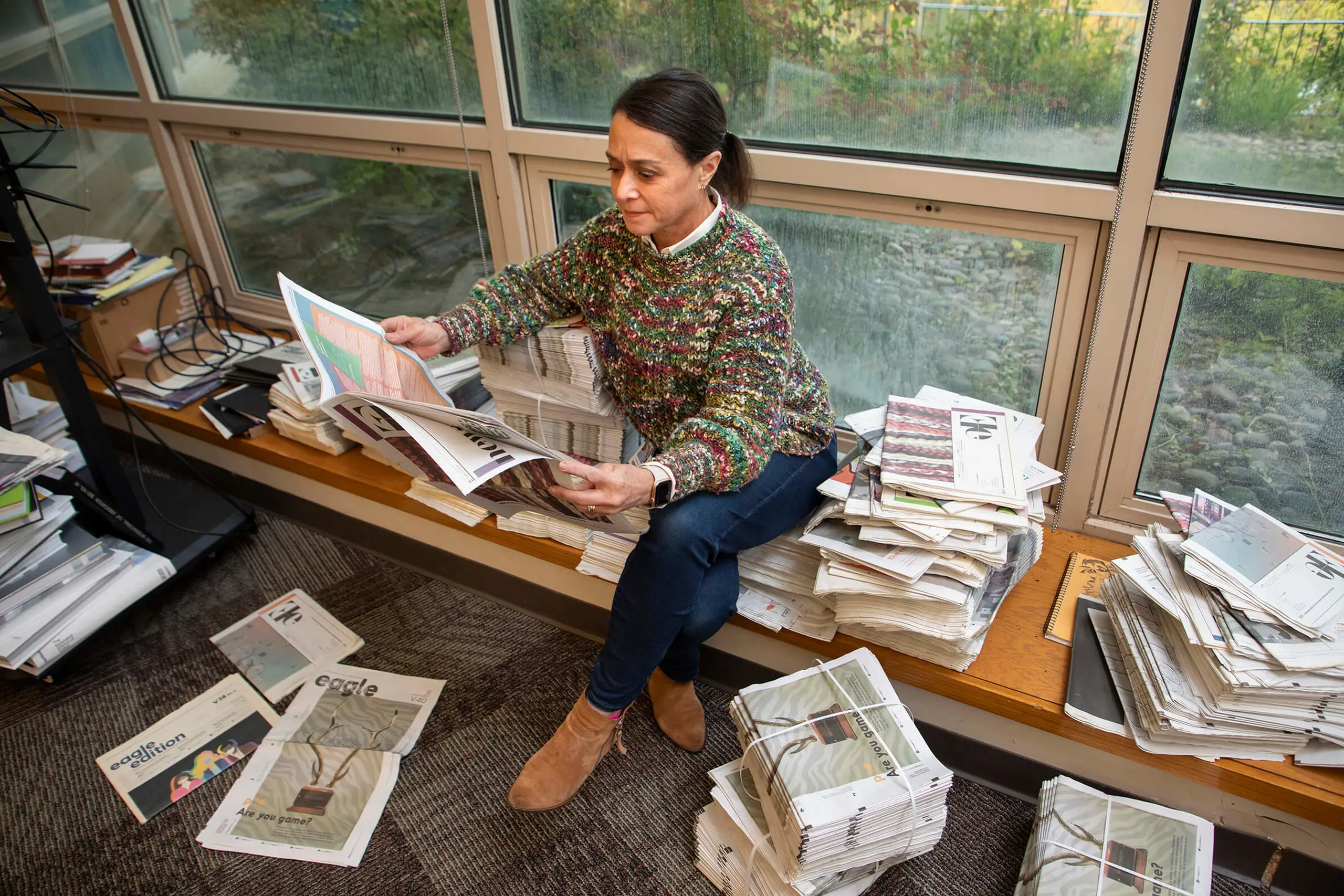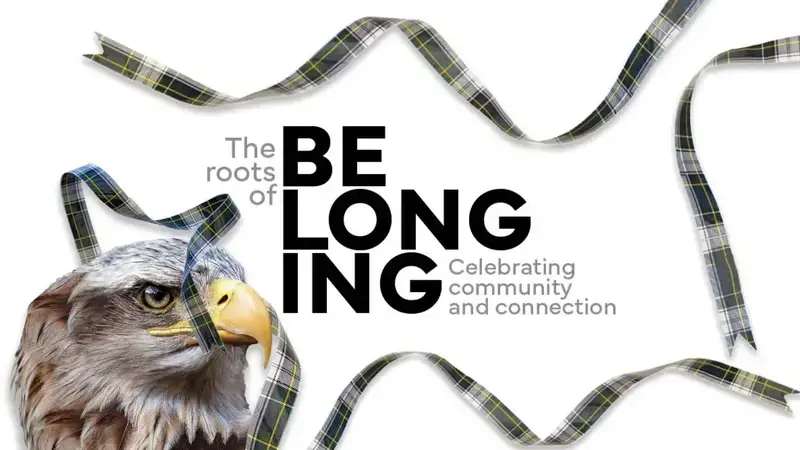The Roots of Belonging: Celebrating Community and Connection
September 30, 2024
This story was initially published in ESD's student newspaper, The Eagle Edition, and was authored by Valentina Boltchi, Sloane Everett, and Emmy Moss.
As the school celebrates its 50th anniversary, Ann and Lee Hobson Head of School Dave Baad emphasizes the theme of belonging in his inaugural chapel talk. He aims to create an inclusive community where every member feels valued.
Ann and Lee Hobson Head of School Dave Baad adds last minute touches on his First chapel talk of the year as he watches the new freshman in the study commons. The freshman cause Baad to wonder: what encourages belonging for all the members in our community?
The theme of belonging takes center stage this year, reflecting the school’s deep rooted commitment to establishing a unified community where every student feels seen. The phrase “purpose and belonging,” largely coined by Baad, has taken shape over the past two years. Last year’s theme placed an emphasis on purpose, with this year being centered on belonging.
The theme of belonging will be tied into announcements, homilies and events for the school year. Upper school was introduced to the theme on the first day of school with Baad’s chapel talk, which was centered around belonging.
“One of Father Swann’s favorite gospels was ‘The 99 Sheep and the One.’ As head of school, I think we need it when it comes to a sense of belonging,” Baad said. “We need to leave the 99 for a minute and go find the one, those people here who don’t feel like they completely belong. We need to figure out what’s happening and address that.”
The theme of belonging involves a question about inclusivity and unity for every student, regardless of when they came to ESD. The experiences of students may alter depending on what grade they came to the school, challenging the theme of “belonging” for all students.
“There are things we do in this community that are meant to be very welcoming and joyful, and sometimes we don’t realize how they might sit with every member of this community,” Baad said. “Part of the work I want to do this year is to do some focus group work with parents and students, belonging is a two way street.”
Lifers, or students who have been at ESD since early childhood, have had more time and experience in the school community.
“Being both a lifer and someone whose parents went to ESD, I feel like belonging is a huge part of our community,” senior Campbell Carothers, who came as a beginner, said. “I think that ESD does a great job of making all students feel seen.”
Many students who have been at ESD since early childhood also feel as though it is a part of their job to help newer students feel included, as being a long time community member also means being a representative of the school.
[This theme] is not something new. It’s not trendy that this year we’re going to focus on purpose and belonging, It’s been who we are since the start of time.”Cindy Newsom,
Director of Admission and Enrollment Management
“Being able to connect with people outside of school in things like sports or social gatherings is the best way I get to know new people,” sophomore Curtis Mathes, also a lifer, said. “I like to include new people so they can feel comfortable and welcomed at ESD.”
Students with more experience and time with peers, traditions and experiences in the school, carry the responsibility to make new students feel welcomed. With such a tight-knit community, new students are able to rely on older students for guidance.
| Read More |
|---|
Belonging Fostered Through Community EngagementOn Aug. 21, the first day of the new school year, junior William Taylor walks confidently to his first class at a school that is new to him. As a new student, finding classes and meeting new people can be a nerve wracking experience. However, instead of being surrounded by unfamiliar faces, Taylor recognizes multiple students from his summer football training, because he has spent hours with them daily for the past month. For new students, sports – especially fall sports – are an effective way to meet classmates before the school year and become involved in the community. “In every class that I walked into on the first day I knew someone from football,” Taylor said. “I definitely think it would have been more challenging [without football], but everyone has been very welcoming.” Taylor was one of four new students in the junior class this year. By playing football, Taylor was able to use pre-season to connect with his teammates and soon-to-be classmates before the year started. “I came to ESD during the spring and lifted with the team,” Taylor said. “And then there was spring football practice so I really got to know the guys on the team.” Junior Isabella Sabol is a new student as well this year. By playing lacrosse during the summer she had the opportunity to meet new people. “Going into any new community in general is hard, especially so late,” Sabol said. “[In lacrosse] we practiced over the summer and I met a lot of new people and it has helped [me] develop stronger bonds with people.” Joining a new school during junior year adds an extra level of stress to the equation. Challenges such as planning schedules and managing credits pile on top of the initial worries of joining an unknown environment. Junior Sophie Slotnik, a new member of the junior class, transferred from Greenhill, which may not be geographically far, but a different community alltogether. “I had a bit of difficulty with creating my schedule and the credits that I needed to earn in order to graduate,” Slotnik said. “I think it would have gone smoother if I came in as a freshman, but I’m very happy with my decision.” Junior Aaron Sada was new to ESD his freshman year and joined the class with 28 other new students. Although moving schools was nothing new to him, as this was his fourth school in Dallas, the community where he was welcomed was nothing like other schools. “Everyone’s really welcoming, no matter how new you are or where you come from,” Sada said. “Even though you might not be best friends with everyone, everyone’s always gonna be nice to you and that’s a very important part of the school.” Belonging does not just affect new high schoolers, but extends to those new to middle school. Students like junior Lyla Zicarelli, who transferred to ESD in fifth grade, entered the new environment along with 11 other students from her past school. “Coming into ESD with people I knew made the transition a lot easier because I didn’t feel alone and I had friends experiencing the same change as me,” Zicarelli said. “I also think because I came in middle school the transition from middle to high school was easier and I had already found my group of people.” ESD has also made a sizable attempt to welcome new faculty into our community as well as making sure existing faculty feel just as connected as the students. Last year, Baad developed the idea of the Belonging and Engagement Advisory Team, and Chief Human Resources Officer Bernadette Gerace organized and headed it. BEAT believes in building bonds within the faculty. “ESD is continuously looking for ways to improve employee engagement,” Gerace said. “We believe it’s important to involve the teachers and staff in that conversation.” BEAT is made up of faculty and staff who are devoted to bringing new faculty into the ESD community. It meets once a month to discuss how they could improve their tactics and to ensure that it is in line with ESD’s mission. “Part of what the BEAT members discussed during the year was how we can serve our new employees, including our new teachers,” Gerace said. “Based on these conversations, we were able to make changes to improve how we welcome our new employees at the beginning of the year.” This team is part of the ESD 2030 plan which aims to have the highest caliber of teachers and faculty available to students. Gerace set up this team so that all the faculty and staff could feel welcome in the community, in order to be the most effective they can be. “John Hattie, a well-known and respected researcher in education, states that the greatest influence on student progression in learning is having inspired and passionate teachers and that collective teacher efficacy has the strongest influence on student achievement, more than any other factor.” Gerace said. “It is important, then, that we do everything we can to ensure that our teachers feel like they belong at ESD, feeling seen, heard and supported.” Bringing Families to The NestJoining a new community can be a challenging experience for families. When families decide to join the ESD community, some might worry about fitting in for the upcoming year. Engaging the families from the beginning of the summer facilitates the transition. Head of admissions Cindy Newsom recognizes this challenge and tries to find new ways to integrate families into the community before the school year starts. “[The] ESD Parents Association hosts buddy families over the summer,” Newsom said. “We will assign people, usually three or four [new] students to one established student so that if they have questions, they can talk to them that way.” Admissions and the Parents Association also hosts events over the summer, so the new students can meet other students in person and connect on a deeper level. “Usually [the events are] focused around community service since that’s a part of our culture, and who we are,” Newsom said. “So there’ll be a community service activity where they can come and meet other students, we try not to make it too overwhelming.” The parent ambassadors answer any questions for potential families. They help connect potential eagles with existing families before making their decision to attend ESD. “Our Parents Association is fabulous,” Newsom said. “We hope our community members will step up and be inclusive of those families and realize that they’re taking a big risk coming in and joining. We want them to feel a part of things.” In order to do so, the Parent Association hosts Zoom calls for prospective families to meet new and current families from their grade. “What we like to talk about is how the folks that are here within our community build and establish a culture and a community that we hope people would want to join,” Newsom said. “We think it’s important for the families to really understand who we are.” After the first week of school, all of the new students gather together during lunch, so that admissions officers can check in and see how everyone is adjusting to the school. The parents also fill out a survey over the summer, so the admissions office can understand where each family is at in their transition, and so the admissions office can see how to help the next year’s new families even more. “We always want to take a look at what we’ve done to see how we can do better next year,” Newsom said. “Sometimes we get some student ambassadors to listen to hear how things are going, what’s going well, and what’s not.” The school not only focuses on belonging for new students, but also on belonging for all students. One of the school’s main goals is to create a closer community, where everyone feels welcome. “We want to make sure everybody feels supported and connected with somebody,” Newsom said. “We want everybody to feel like they have a person on campus.” The upper school advisory system is another way new and returning students meet and connect with each other. The program addresses the importance of building relationships within the community. Every Tuesday and Friday, each advisory meets to participate in fun activities to hopefully draw closer together. “The advisory system is kind of a safety net,” Newsom said. “We work with the advisors to really promote those types of things to get kids plugged in, to hopefully find their people.” The community activity requirements were placed this year in order to intertwine the student body even further, by building new relationships. A community activity includes joining a sports team, participating in a production or joining the robotics team. “I actually see it as a belonging initiative,” Baad said. “I think people develop a much stronger sense of belonging to ESD when they are involved in an activity that has some sort of social goal that they are trying to meet.” The idea of a tight community has been paramount within ESD since 1974. It started when the first class sat around a campfire with Fr. Swann and shared their aspirations for the school. That tradition of sitting together has been carried down throughout the years by the circle tables in the study commons and the dining hall. These tables symbolize that moment in history and the feeling of belonging that ESD carries. “[This theme] is not something new. It’s not trendy that this year we’re going to focus on purpose and belonging,” Newsom said. “It’s been who we are since the start of time.” |





